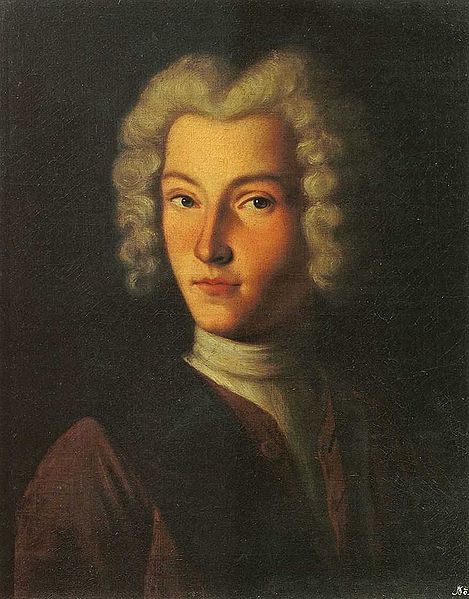<Back to Index>
- Lexicographer Pierre Athanase Larousse, 1817
- Architect Ange-Jacques Gabriel, 1698
- Emperor and Autocrat of All the Russias Peter II, 317
PAGE SPONSOR

Pyotr (Peter) II Alekseyevich (Russian: Пётр II Алексеевич) (23 October [O.S. 12 October] 1715 – 30 January [O.S. 19 January] 1730) was Emperor of Russia from 1727 until his death. He was the only son of Tsarevich Alexei Petrovich, son of Peter I of Russia by his first wife Eudoxia Lopukhina, and Princess Charlotte, daughter of Duke Louis Rudolph of Brunswick-Lüneburg and sister-in-law of Charles VI, Holy Roman Emperor. He was also the only male-line grandson of Peter the Great.
Peter was born in Saint Petersburg on 18 October 1715 (Julian calendar). From his childhood the orphan grand duke was kept in the strictest seclusion. His grandfather, Peter the Great, systematically ignored him. His earliest governesses were the wives of a tailor and a vintner from the Dutch settlement; a sailor called Norman taught him the rudiments of navigation; and, when he grew older, he was placed under the care of a Hungarian refugee, Janos Zeikin, who seems to have been a conscientious teacher.
During the reign of Catherine I, Peter was quite ignored; but just before her death it became clear to those in power that the grandson of Peter the Great could not be kept out of his inheritance much longer. The majority of the nation and three-quarters of the nobility were on his side, while his uncle, Emperor Charles VI, through the imperial ambassador at Saint Petersburg, persistently urged his claims. The matter was arranged between Aleksandr Danilovich Menshikov and Count Andrei Osterman; and on 18 May 1727 Peter II, according to the terms of the forged last will of Catherine I, was proclaimed sovereign autocrat.
The senate, the privy council and the guards took the oath of allegiance forthwith. The education of the young prince was wisely entrusted to the vice-chancellor Ostermann. Menshikov, who took possession of Peter II and lodged him in his own palace on the Vasilievsky Island, had intended to marry Peter to his daughter Maria. For a few months in the summer of 1727, "Not even Peter the Great was so feared or so obeyed" according to the Saxon ambassador. Menshikov became arrogant and domineering. He issued orders to the Emperor himself and then removed a silver plate that Peter had just given as a gift to his sister Natalya. To which the Emperor replied, "we shall see who is emperor, you or I." Then after Menshikov had recovered from a brief illness, Peter turned his back on him and said, "You see, I am at last learning how to keep him in order." Soon, Menshikov was arrested (21 September 1727); but Peter only fell into the hands of the equally unscrupulous Prince Vasily Lukich Dolgorukov, who carried him away from Petersburg to Moscow. Peter's coronation was celebrated at that city on 25 February 1728. He was betrothed to his mentor's niece, Princess Catherine Dolgorukova, and the wedding was actually fixed for 30 January 1730; but on that very day the emperor died of smallpox.
He is buried in the Kremlin, the only post-Petrine Russian monarch given that honor. In fact, with Ivan VI (who was murdered and buried in the fortress of Shlisselburg), he is the only post-Petrine monarch not buried in the Peter and Paul Cathedral in Saint Petersburg.
With Peter's death, the direct male line of the Romanov Dynasty ended. He was succeeded by Anna Ivanovna, daughter of Peter the Great's half-brother and co-ruler, Ivan V.